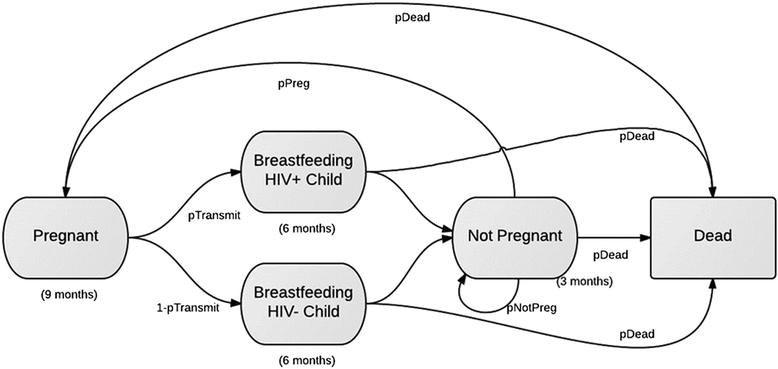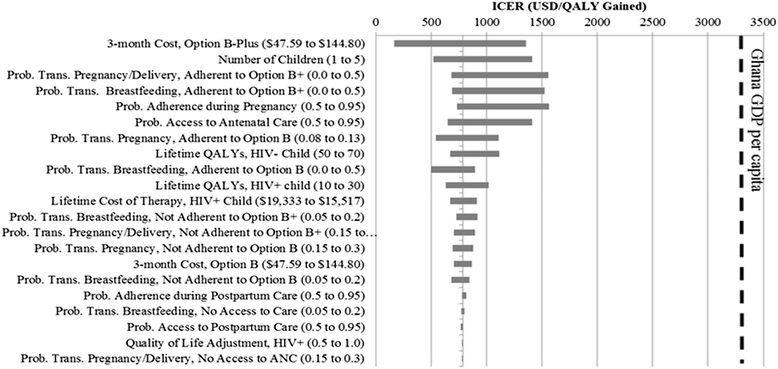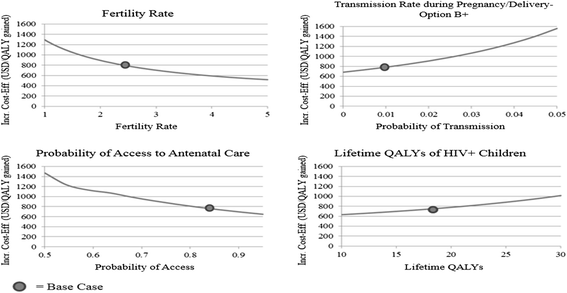Cost effectiveness of option B plus for prevention of mother-to-child transmission of HIV in resource-limited countries: evidence from Kumasi, Ghana
- PMID: 25887574
- PMCID: PMC4374181
- DOI: 10.1186/s12879-015-0859-2
Cost effectiveness of option B plus for prevention of mother-to-child transmission of HIV in resource-limited countries: evidence from Kumasi, Ghana
Abstract
Background: Achieving the goal of eliminating mother-to-child HIV transmission (MTCT) necessitates increased access to antiretroviral therapy (ART) for HIV-infected pregnant women. Option B provides ART through pregnancy and breastfeeding, whereas Option B+ recommends continuous ART regardless of CD4 count, thus potentially reducing MTCT during future pregnancies. Our objective was to compare maternal and pediatric health outcomes and cost-effectiveness of Option B+ versus Option B in Ghana.
Methods: A decision-analytic model was developed to simulate HIV progression in mothers and transmission (in utero, during birth, or through breastfeeding) to current and all future children. Clinical parameters, including antenatal care access and fertility rates, were estimated from a retrospective review of 817 medical records at two hospitals in Ghana. Additional parameters were obtained from published literature. Modeled outcomes include HIV infections averted among newborn children, quality-adjusted life-years (QALYs), and cost-effectiveness ratios.
Results: HIV-infected women in Ghana have a lifetime average of 2.3 children (SD 1.3). Projected maternal life expectancy under Option B+ is 16.1 years, versus 16.0 years with Option B, yielding a gain of 0.1 maternal QALYs and 3.2 additional QALYs per child. Despite higher initial ART costs, Option B+ costs $785/QALY gained, a value considered very cost-effective by World Health Organization benchmarks. Widespread implementation of Option B+ in Ghana could theoretically prevent up to 668 HIV infections among children annually. Cost-effectiveness estimates remained favorable over robust sensitivity analyses.
Conclusions: Although more expensive than Option B, Option B+ substantially reduces MTCT in future pregnancies, increases both maternal and pediatric QALYs, and is a cost-effective use of limited resources in Ghana.
Figures




References
-
- UNAIDS. World AIDS Day Report. 2012. [http://www.unaids.org/en/media/unaids/contentassets/documents/epidemiolo...]
-
- UNAIDS. Eliminating new HIV infections among children. [http://www.unaids.org/en/targetsandcommitments/eliminatingnewhivinfectio...]
-
- WHO. Global Monitoring Framework and Strategy for the Global Plan towards the elimination of new HIV infections among children by 2015 and keeping their mothers alive (EMTCT). 2012. [http://apps.who.int/iris/bitstream/10665/75341/1/9789241504270_eng.pdf] - PubMed
-
- UNICEF. At a Glance: Ghana - Statistics. 2007. [http://www.unicef.org/infobycountry/ghana_statistics.html]
Publication types
MeSH terms
Substances
Grants and funding
LinkOut - more resources
Full Text Sources
Other Literature Sources
Medical
Research Materials

